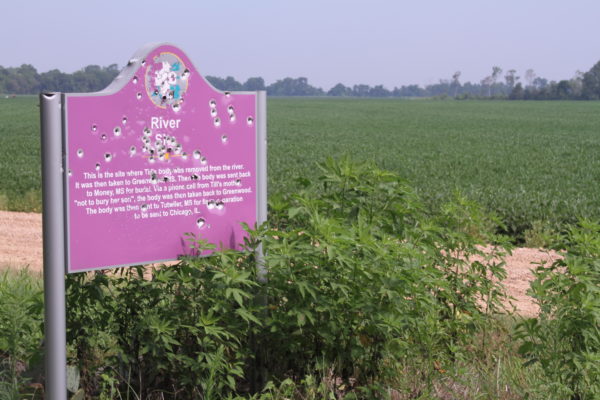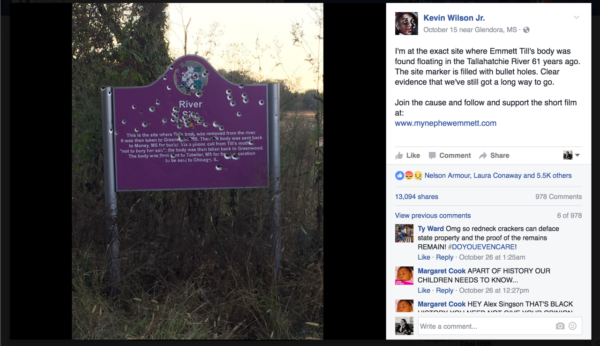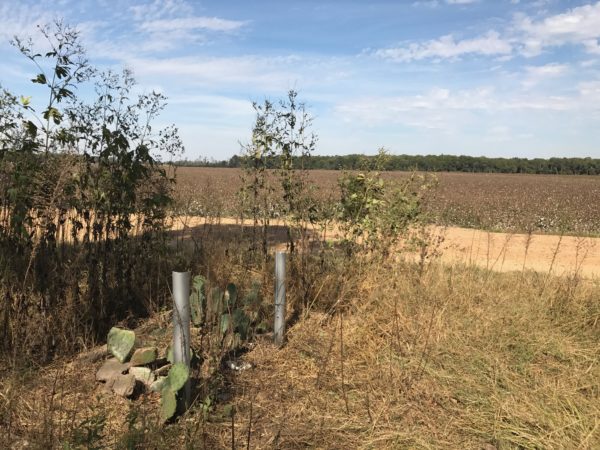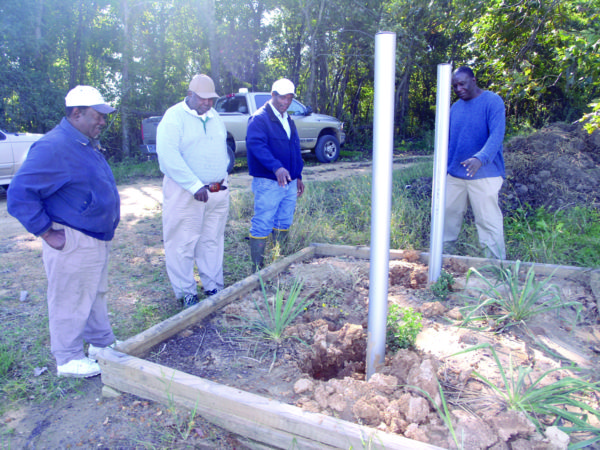Notes
A Brief Visual History of the Bullet-Riddled Emmett Till Memorial Sign

In April 2008, the Emmett Till Memorial Commission used $1,250 of Morgan Freeman’s money to erect a historical marker on the banks of the Tallahatchie River. It marked the spot where they believed Emmett Till’s body was pulled from the water.
On October 15, 2016, NYU film student Kevin Wilson Jr. found the sign filled with bullet holes. He posted a picture to his Facebook account and it quickly went viral. Thousands of “shares” later, the image of the bullet-riddled sign acquired a ubiquitous presence on the web. A cheap, purple sign, filled with holes, some questionable history, and a chipped magnolia flower—the image has generated intense and visceral affective responses. It has generated moral outrage and a fundraising campaign—both of which are healthy and needed.
But the moral outrage has been too-quickly channeled into the particular matter of the sign and its replacement—as if all objections would be resolved once the sign was replaced. Moreover, alongside the outrage, the photograph also generated a disturbing undercurrent of indifference—why talk about one more rural sign vandalized by one more group of fun-loving, beer-drinking teenagers who would shoot a speed-limit sign as quickly as a historical marker of a race-driven murder.

Because of this indifference, it is essential that we understand the now-viral image in the long context of Emmett Till photography, Emmett Till commemoration, and vandalism. So contextualized, the photograph points us toward cultural issues more pressing than a broken sign. Consider the following.
Kevin Wilson’s Facebook post was not the first time an Emmett Till photograph had gone viral.
Sixty-one years before Wilson posted the vandalized sign, fourteen-year-old Emmett Till was lynched. He had violated the racial mores of the 1955 Mississippi Delta by whistling at a white woman. For this, he was kidnapped, tortured, shot, and dropped into the Tallahatchie River. His body was shipped home to Chicago via the northward-bound Illinois Central in a casket bearing the official seal of the state of Mississippi and an order that the casket not be opened.
His mother refused. She ordered the seal to be broken and asked for an open-casket funeral. Thousands upon thousands of Chicagoans saw Till’s disfigured face. David Jackson took a picture and published it in Jet magazine. It is difficult to overstate the influence of that picture. Jet’s 400,000 print run sold out, the picture was reproduced countless times, it was smuggled into the Delta by black porters on the southward-bound Illinois Central, and it became the shared starting point of what SNCC’s Joyce Ladner called “The Emmett Till Generation”: hundreds of Mississippi activists whose political awakening could be traced to David Jackson’s picture of Emmett Till.
While the photograph may have inspired a generation of activists, it did not inspire much in the way of local commemoration. Indeed, for the first forty-nine years and eleven months after Till was murdered, there was not a single built memorial anywhere in the state of Mississippi.
On July 1, 2005, the first two memorials went up. Blue roadside markers were erected thirty miles apart from each other outside the towns of Greenwood and Tutwiler. The occasion was the dedication of a thirty-mile stretch of Highway 49E as the “Emmett Till Memorial Highway.” While this may have been a symbolic gesture, it gave the memory of Emmett Till something it had never had before: a material presence on the landscape of the Mississippi Delta.
Vandalism quickly followed. By June 2006, the Greenwood sign was spray-painted with the letters “KKK.” In October 2007, Sumner resident Carolyn Webb found Sammy Joe Spinoza poised to rip a freshly minted sign out of the sidewalk on Sumner’s town square. One year later, in October 2008, the sign that Kevin Wilson recently found punctured by bullets was stolen. The tire treads from the suddenly-empty aluminum posts to the riverbank led Tallahatchie County Sheriff William Brewer to surmise that the sign was now at the bottom of the river. Although the Emmett Till Memorial Commission (ETMC) replaced the sign, the new one was filled with bullet holes by the spring of 2013.
Thus it was that by the time Kevin Wilson “discovered” the vandalized sign in October of 2016, Emmett Till commemoration was scarred by a ten-year history of vandalism. The pockmarked sign had been stolen, replaced, and shot-through for three years before Wilson arrived.
It is important to remember this longer history of violence against Emmett Till commemoration. By comparing the cultural responses to the vandalism of the same sign in 2008 and 2016, we can learn important things about race, commemoration, and American culture.
First, the long history of vandalism makes it impossible to understand the bullet holes as a form of innocent fun.

Both 2008 and 2016 featured two common responses to the vandalism. Some saw the violence as clear-cut evidence of racism. In 2008, County Supervisor Jerome Little told Sheriff Brewer that a “white person” must have stolen the sign. Little suggested that local whites were “hot because they might be fixing to get a black president.” In a similar vein, Public Relations Commissioner for the ETMC Jesse Jaynes noted, “To us, it feels like they’re re-enacting [the Till case,]” she said. “They threw this sign in the river, just like the body of Emmett Till was thrown into the river.”
Others refused to read the vandalism as racism. It was just, the argument ran, a sort of equal-opportunity vandalism: teenagers with guns and beer will shoot up any rural sign. From this perspective, it was Jerome Little who was racist. In a storm of letters to the editor, a wide range of citizens promptly called on Little to apologize (which he did) and to resign (which he did not).
These two arguments recurred in 2016. While some of my closest contacts in Mississippi continue to peddle the “boys will be boys” line, I have argued that the vandalism must not be reduced to harmless teenage angst. It has gone on for too long and been too narrowly focused on the same targets to be interpreted as anything but a specific attack on Till commemoration. Indeed, this is the first reason we need to place Kevin Wilson’s viral photograph in its historic perspective. Without seeing the shot-up sign in the context of a twelve-year history of violence, it becomes that much easier to dismiss the bullet holes as the “innocent” result of disaffected teens.
Second, the long history of Till vandalism teaches us something about the important work of Black Lives Matter in our current cultural moment.
The vandalized sign made only a minor media splash in 2008. While it was covered by the local Sun-Sentinel and even written up at Daily Kos, neither the image of the missing sign nor fact of the theft registered in the public imagination. A fundraiser organized by the William Winter Institute for Racial Reconciliation barely mustered $1000.

These numbers don’t compare with the 2016 response. Wilson’s original post has been shared over 13,000 times (to date) and has been covered by virtually every major media outlet, including CNN, ABC, NBC, Time, the Washington Post, the New York Times, and the BBC. This time, fundraising was organized by my collaborator Patrick Weems at the Emmett Till Interpretive Center. They raised over $40,000 and a Brooklyn, NY sign company offered to produce and ship a replacement sign—a bullet proof one.
Why the dramatic shift in the 2016 iteration of the vandalized sign? What has happened to our country in the last eight years that the same sign, twice vandalized, could produce such disparate responses?
The 2016 response suggests that our culture is in a historically unique moment. In ways that were not true in 2008, our racial climate is marked by a new sense (although not a new reality) that violence is unequally distributed, a sudden hopefulness born from the fact that more people are paying attention, and a despair rooted in the fact that the racial distribution of violence suddenly seems ubiquitous.
At the root of this cultural shift, and at the root of the massive response to Wilson’s post, is Black Lives Matter—as the name for both a social movement and an ever-expanding, publically available list of the black victims of institutional violence.
Although Till was not killed by the police, his youth, his innocence, and the impunity of the confessed killers have made his murder an iconic image of institutional brutality. Indeed, it is not too much to say that the lynching of Emmett Till has become the chosen pre-history of Black Lives Matter. Till’s torture and murder have provided a constantly-invoked point of comparison, an ur-moment of institutional violence against African-Americans. As John Edgar Wideman put it in Esquire, “Before Eric Garner, Tamir Rice, and Trayvon Martin, there was Emmett Till.” Given this roster of associations, it is no wonder Kevin Wilson’s post went viral. Since Ferguson, MO, Till has become an archetypal victim of black violence; the sign has become a symbol that, even in Mississippi, such violence is no longer permitted in the public realm; and, finally, the destruction of the sign triggered outrage because it was read, correctly, as the public rebuke of an effort to condemn racial violence.
Jesse Jaynes knew all of this in 2008; the vandalized sign was the Till murder all over again.
In a conversation between myself and Ralph Eubanks published on Literary Hub, Eubanks makes a great point about Kevin Wilson’s photograph. The vandalism, he says, reminds him of the state seal on Emmett Till’s casket intended to confine to oblivion the evidence of violence. And this brings us full circle. Kevin Wilson’s 2016 photograph shares something in common with David Jackson’s 1955 photograph. Both bore witness to terror. And, more importantly, the overwhelming response to both pictures bear witness to the fact that neither state seals nor bullets can hide the institutional violence that has for too long been perpetrated against black bodies.
— Dave Tell
If you are so inclined, you can support the commemoration of Emmett Till by going to the webpage of the Emmett Till Interpretive Center. Full disclosure: the Interpretive Center is using some of the donated funds to support the Emmett Till Memory Project, an initiative I lead to provide an electronic commemorative infrastructure for the Mississippi Delta. You can’t shoot an app.
(photo: Courtesy of Pablo Correa/Emmett Till Memory Project. photo 2: Maude Schuyler Clay caption: Current site of the marker. It has been taken down in preparation for replacement. The last remnants of cotton are still visible in the background of this picture. photo 3: Clay McFerrin/The Sun-Sentinel caption: From left, R.B. Hill, Willie Hill, Bobby Banks and Jerome Little discuss a missing historical marker near the site where the body of Emmett Till was pulled from the Tallahachie River. The marker was discovered missing, Sunday, October 26, 2008.)


Reactions
Comments Powered by Disqus